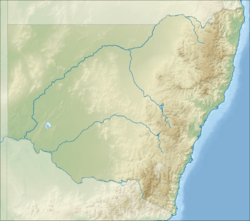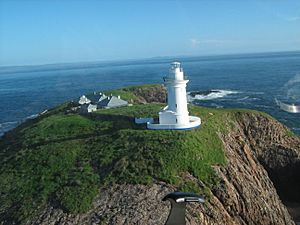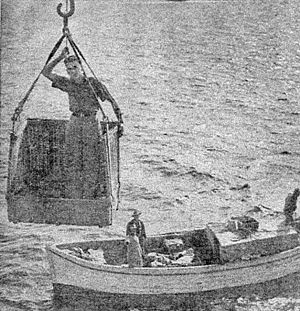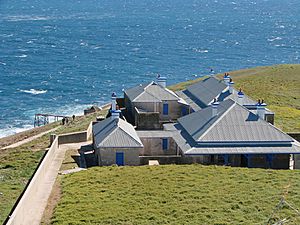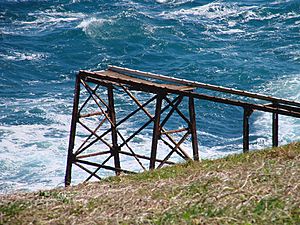South Solitary Island Light facts for kids
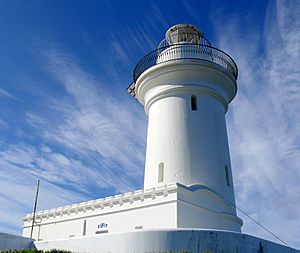 |
|
| South Solitary Island Light, 2009 | |
|
|
|
| Location | South Solitary Island New South Wales Australia |
|---|---|
| Coordinates | 30°12′24.33″S 153°16′2.52″E / 30.2067583°S 153.2673667°E |
| Year first constructed | 1880 |
| Automated | 1975 |
| Construction | concrete tower |
| Tower shape | cylindrical tower with double balcony and lantern |
| Markings / pattern | white tower and lantern |
| Height | 66 feet (20 m) |
| Focal height | 190 feet (58 m) |
| Original lens | 1st order dioptric Fresnel lens |
| Intensity | 38,000 cd |
| Range | 15 nautical miles (28 km; 17 mi) |
| Characteristic | Fl.W. 5s |
| Admiralty number | K2812 |
| NGA number | 111-5976 |
| ARLHS number | AUS-152 |
The South Solitary Island Light is a working lighthouse located on South Solitary Island. This island is part of the Solitary Islands Marine Park. It is about 15 kilometres (9.3 mi) northeast of Coffs Harbour in New South Wales, Australia.
The lighthouse stands at the highest point of the island. It is known as the most isolated lighthouse along the New South Wales coast. This lighthouse was the first in New South Wales to use kerosene for its light. It was also the last one to use kerosene before switching to electric power.
Contents
History of the South Solitary Island Light
People started suggesting a lighthouse near Coffs Harbour as early as 1856. They thought about placing it on either North Solitary Island or South Solitary Island. Ship captains preferred South Solitary Island, so that became the chosen spot.
The lighthouse was designed by James Barnet, who was the Colonial Architect at the time. It is one of three concrete lighthouses built during that period. The other two are Smoky Cape Lighthouse and Green Cape Lighthouse. Barnet visited the island in October 1877. He wanted to find the best places for the buildings and where to get materials.
Building the lighthouse was hard work. Workers had to bring cement and sand to the island in tough conditions. They got broken stone from the island itself. Timber came from Bellingen on small boats. The lighthouse was supposed to be finished by 1879. You can even see "18VR79" carved above the entrance. But the light was first turned on later, on March 18, 1880.
The first lens used was a special Fresnel lens made by Chance Brothers. It was the second of its kind used in Australia. Today, you can see this original lens at the Coffs Harbour Regional Museum.
The first light source was a kerosene burner. This was new for lighthouses in New South Wales. Other lighthouses used colza oil at that time. While other lighthouses upgraded to kerosene, then to carbide lamps, and later to electricity, South Solitary kept using kerosene until 1975. This made it the last lighthouse in New South Wales to use kerosene. The light shone from 192 feet (59 m) above sea level. It could be seen for 16 nautical miles (30 km; 18 mi).
By 1934, the light was very bright, at 205,000 candela. It flashed white once every 30 seconds.
Life at the Lighthouse
Life on South Solitary Island was difficult because it was so isolated. The weather could also be very harsh. At first, supplies came from Sydney by steamer every two weeks, if the weather allowed. Later, supplies arrived more regularly by launch from Coffs Harbour.
Getting supplies onto the island was tricky. Workers used a crane to lower a basket from the island to the launch. Then, they hauled the supplies up a steep concrete path. The homes on the island used kerosene for light until the 1950s. Coal was used for heating and cooking.
Communicating with the mainland was also a challenge. They first used a signal lamp or a heliograph (a device that uses sunlight). In 1937, a pedal radio was installed. This allowed them to talk to the Norah Head Lightstation. Later, a Bendix radio replaced it. The lighthouse keepers' children learned their lessons from a governess at first. Later, they used correspondence courses.
During World War II, in May 1942, the lighthouse light was turned off. This was the only time it was ever turned off. Several ships were attacked by enemy submarines near the island, so the light was switched off for safety.
Modern Upgrades
In 1974, the flagstaff was removed, and a helipad was built. This made it easier to reach the island. On August 22, 1975, the lighthouse was updated to use electricity from solar power. It also became automated, meaning it no longer needed people to operate it. The lighthouse keepers officially left on December 28, 1975.
The old lens was replaced with a new one. A new lantern made of fibreglass and aluminum took the place of the old structure. This change lowered the light's height to 190 feet (58 m) above sea level. The old lantern was moved to the Coffs Harbour Regional Museum by a RAAF Chinook helicopter on September 7, 1977.
The 21st Century
In 2000, the lighthouse station was given to the National Parks and Wildlife Service. In 2004, the Department of Environment, Climate Change and Water spent money to fix the buildings. They made them weatherproof and secure, but not ready for people to live in.
In 2020, the Australian Maritime Safety Authority started a big project. They are restoring the crumbling cement and repainting the lighthouse. This project costs about $1.5 million AUD.
How the Light Works Today
The light today uses solar power. It is a 12 V, 3 amp lamp. It shines with an intensity of 38,000 candela. The light flashes white once every five seconds. It can be seen for 15 nautical miles (28 km; 17 mi). Helicopters are used to maintain the light.
Lighthouse Structures
The Lighthouse Tower
The tower itself is 40 feet (12 m) tall from the ground to the lantern. It is made of solid concrete. Unlike later lighthouses of its kind, which were octagonal, this one is round. The inside of the tower is 40 feet (12 m) across. The walls get thinner as they go up. They are 4 feet 6 inches (1.37 m) thick at the bottom and 2 feet 3 inches (0.69 m) at the top.
The top of the tower has a concrete ledge called a cornice. On top of this is the gallery, where the light sits. This gallery is made of sixteen large basalt blocks, each weighing 30 long hundredweight (3,400 lb; 1,500 kg). These blocks were brought from Melbourne. A metal handrail surrounds the gallery. Inside the tower, three sets of cast-iron stairs lead up to the lantern room. A small building for storage is attached to the tower.
Other Buildings on the Island
The lighthouse keepers' homes include one main cottage for the chief keeper. There are also two cottages for the assistant keepers, which are joined together. These homes are made of concrete, then covered and painted. High stone walls surround the homes to protect them from bad weather. Another tall stone wall runs from the houses to the lighthouse. There was also a small room near the homes that served as a schoolhouse. A governess taught the keepers' children there.
You can also see the remains of a jetty on the island. This jetty was 13 metres (43 ft) above sea level and was the third one built. The first jetty was built in 1878 when the lighthouse was being constructed. It was only 5 metres (16 ft) high. It was destroyed in 1904, and a bigger one was built. This second jetty was repaired many times. Finally, the third jetty was built in 1959. The part of the jetty closest to the shore was taken down in 1986. As of 2008, most of the jetty has rusted and fallen into the sea. A small, old storehouse stands next to the jetty. This storehouse is the oldest building on the island, built in 1879–1880.
Visiting the Lighthouse
The Australian Maritime Safety Authority operates the light. The New South Wales Maritime Parks Authority manages the island as part of the Solitary Islands Marine Park. Usually, the island is not open to the public. However, you can see the lighthouse from boat tours that leave from Coffs Harbour.
The island is open for special tours two weekends each year. You can only get there by helicopter. Rangers from the National Parks and Wildlife Service guide these tours.


